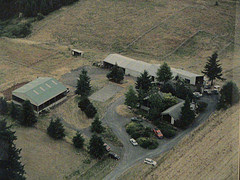With O’Reiley just 15 minutes away, I thought for sure I’d get a lot of lessons on riding. I got a few here and there. But for the most part, I was learning more about the other end of the business.
The lessons were easy and well rehearsed. How to scoop up the poop, clean the water trough, catch the horse, buy, load and unload tons of hay, brushing, hoof picking, managing muddy pastures, etc. Lessons learned:
(1) tack is not reversible. The horse really looks funny and snorts at you when the halter is done wrong. Solution: Practice, practice practice.
(2) a horse will fill its lungs and inflate his torso so that your seemingly set saddle will eventually find itself upside down on its belly. Solution: let Melissa ride O’Reiley first.
(3) a horse that doesn’t want to be caught in open pasture, is a futile chase. Solution: operand conditioning; shake the grain bucket and think like a horse. One time, O’Reiley did not want to come to the barn because he was out socializing with the mules. I volunteered to get him. With halter in hand, I crossed the pasture and headed straight to the closest mule. I reached over the fence and offered him O’Reiley’s treat. I begged the gentle mule to be excused then headed to a now stunned horse. Caught him, haltered him and led him to the barn. Melissa said I was a natural.
Of course, after hours of labor, there were actual riding lessons. The biggest lesson, the hardest to learn, was not how to ride … it was how to fall. Riding lessons were a controlled exercise. Melissa was usually at the other end of the longe line while I practiced what she was telling me to do. To prepare for the eventual fall, all I had was this sage advice: (1) kick off the stirrups, (2) get away from the horse’s feet, etc. Finally, one is supposed to get back on the horse after a fall. How ridiculous is that?
All these lessons were rushing though my brain on my first un-tethered ride. I pointed O’Reiley towards the path. He kindly made me think I led him. We went down towards the creek, then up the rise towards his gossip fence. This is the same fence along which he races the mules. All was well until I tried to turn him for the barn. O’Reiley raised and turned his head to look at me squarely. He gave me one look as if to say, “Really?” “Really”, I thought, shaking the slack reins close to my chest. The next shake of the reins accelerated him towards a gallop. Perhaps I could get him to whoa, but not. Within the first two or three transitional gaits, I knew to rack up the falling advice and put it to good use.
I kicked off the stirrups and felt a launch sideways and upwards. In a moment I was on my back seeing stars in broad daylight. A quick self check and a slow rolling rise brought O’Reiley into view about 50 yards away. He had kept going but curved his head around to look at me like, “What are you doing down there?” I made it back to the barn after responding. “I’m OK!” to Melissa’s hail. To my horror I was told, “You gotta get back on!” I did, but very quickly got off. It was a lesson felt for the next two or three days.
A good fall is one which you can walk away from in one piece.

